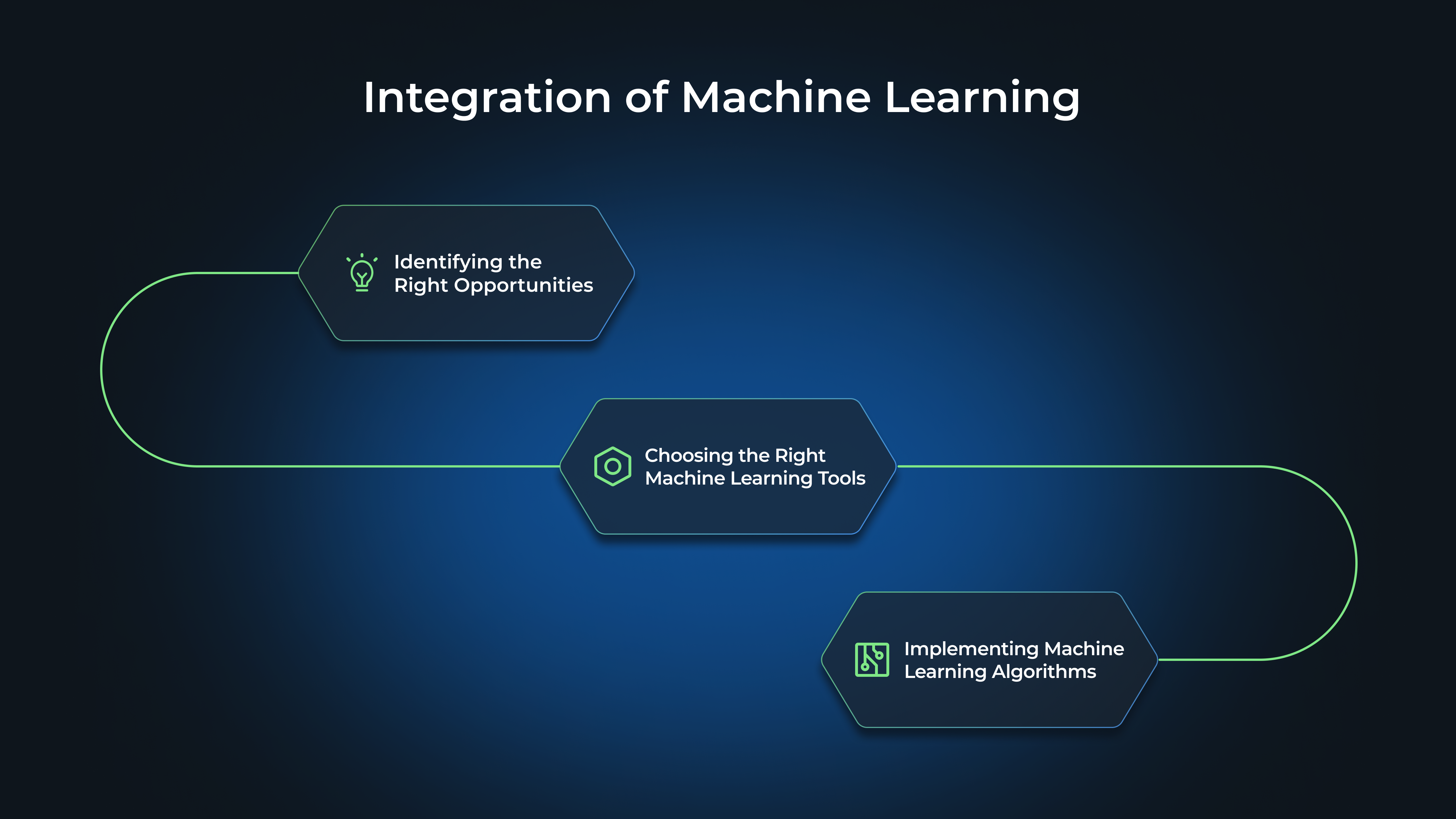We at WeSoftYou understand that integrating machine learning into your software development process can seem like a daunting task. However, with the right approach and preparation, it can lead to significant improvements in your software’s capabilities and functionality. In this article, we will guide you through the necessary steps to successfully integrate machine learning into your software development process, ensuring that you can leverage its power to achieve better results.
The Basics of Machine Learning
Before diving into the integration process, it’s crucial to grasp the basics of machine learning, a subset of artificial intelligence that focuses on developing algorithms enabling software systems to learn and make predictions without explicit programming. These algorithms are trained on large datasets to identify patterns, make predictions, and continually enhance their performance, mimicking the way humans learn from experience. Analyzing data and uncovering hidden patterns using statistical techniques are key components, allowing algorithms to make predictions or decisions based on new, unseen data.
Machine learning is broadly defined as the process of training software algorithms to learn from data and make accurate predictions or decisions. Leveraging statistical techniques and computational power, it extracts insights from vast amounts of data. Different types of machine learning algorithms exist, such as supervised learning, trained on labeled data with known outcomes, and unsupervised learning, which operates on unlabeled data to identify patterns without predefined outcomes.
Machine learning plays a pivotal role in software development by enabling the creation of intelligent systems that adapt and improve over time. Integration enhances the accuracy and efficiency of tasks like data analysis, pattern recognition, and decision-making. Notably, machine learning excels in handling large and complex datasets, swiftly analyzing vast amounts of data and automating repetitive tasks, such as data cleaning. This automation allows developers to focus on more complex and creative aspects of their work.
Moreover, machine learning improves decision-making accuracy by training algorithms on historical data, enabling them to learn from past experiences. This is particularly beneficial in areas like fraud detection, where algorithms can identify patterns associated with fraudulent activities and flag suspicious transactions. In conclusion, understanding the basics of machine learning is essential for effective integration into the software development process. By leveraging machine learning algorithms, developers can create intelligent systems that evolve over time, leading to more accurate and efficient software applications.
How to Prepare for Machine Learning Integration?
Before embarking on the integration process, it’s important to ensure that your team is adequately prepared to work with machine learning technologies.
Integrating machine learning into software development can be a complex task that requires a team with a diverse set of skills. While it’s crucial to have expertise in programming languages such as Python, R, or Java, there are other necessary skills that can greatly contribute to the success of the integration.
Necessary Skills for Machine Learning
From our experience, the successful integration of machine learning in software development requires a team with a diverse set of skills. These include expertise in programming languages such as Python, R, or Java, knowledge of statistical analysis and algorithms, and familiarity with machine learning frameworks and libraries like TensorFlow or scikit-learn.
Having a solid foundation in programming languages allows your team to effectively implement and manipulate machine learning algorithms. Additionally, a strong understanding of statistical analysis and algorithms is essential for interpreting and analyzing the data that will be used in the machine learning process.
Familiarity with machine learning frameworks and libraries like TensorFlow or scikit-learn is also crucial. These tools provide pre-built functions and algorithms that can greatly simplify the integration process. They allow your team to focus on the specific problem at hand, rather than spending time on developing and implementing complex algorithms from scratch.
Training Your Team for Machine Learning
To equip your team with the necessary skills, consider organizing training sessions or workshops on machine learning. This can help them understand the concepts, techniques, and tools involved, allowing them to work efficiently with machine learning algorithms and models.
During these training sessions, your team can learn about the different types of machine learning algorithms, such as supervised learning, unsupervised learning, and reinforcement learning. They can also explore various techniques for data preprocessing, feature engineering, and model evaluation.
Furthermore, hands-on exercises and projects can provide valuable practical experience. By working on real-world problems and datasets, your team can gain a deeper understanding of how machine learning can be applied in different domains and industries.
Additionally, encourage your team to stay updated with the latest advancements in machine learning. This can be done through attending conferences, participating in online courses, or joining relevant communities and forums. By staying informed about the latest trends and techniques, your team can continuously improve their skills and adapt to the ever-evolving field of machine learning.
Step-by-Step Integration of Machine Learning in Software Development Process

Now that your team is prepared, let’s explore the steps involved in integrating machine learning into your software development process.
Step 1. Identifying the Right Opportunities for Machine Learning
Not every software application may benefit from machine learning integration. It’s important to identify the areas where machine learning can provide the most value. From our experience, tasks such as fraud detection, sentiment analysis, and recommendation systems are common use cases for machine learning in software development.
When it comes to fraud detection, machine learning algorithms can analyze patterns and anomalies in large datasets to identify potential fraudulent activities. By leveraging machine learning, software applications can detect and prevent fraudulent transactions in real-time, saving businesses significant financial losses.
Sentiment analysis is another area where machine learning can be highly beneficial. By analyzing text data, machine learning algorithms can determine the sentiment behind customer reviews, social media posts, and other forms of user-generated content. This allows software applications to understand customer feedback at scale, enabling businesses to make data-driven decisions and improve their products or services accordingly.
Recommendation systems are widely used in e-commerce platforms, streaming services, and social media platforms. By leveraging machine learning algorithms, these systems can analyze user behavior and preferences to provide personalized recommendations. This not only enhances the user experience but also increases customer engagement and drives sales.
Step 2. Choosing the Right Machine Learning Tools
There are numerous machine learning tools and frameworks available, each with its own strengths and weaknesses. It’s crucial to choose the right tools based on your requirements and the expertise of your team. From our experience, TensorFlow, scikit-learn, and PyTorch are widely used and offer robust capabilities for machine learning integration.
TensorFlow, developed by Google, is an open-source library widely used for building and deploying machine learning models. It provides a flexible architecture that allows developers to create and train models using various algorithms and techniques. TensorFlow also offers tools for data preprocessing, visualization, and model deployment, making it a comprehensive solution for machine learning integration.
Scikit-learn is another popular machine learning library that provides a wide range of algorithms and tools for data preprocessing, model selection, and evaluation. It is known for its simplicity and ease of use, making it a great choice for developers who are new to machine learning. Scikit-learn also integrates well with other Python libraries, making it a versatile option for machine learning integration.
PyTorch, developed by Facebook, is a deep learning framework that provides dynamic computational graphs and automatic differentiation. It is widely used for building and training neural networks, especially in the field of computer vision and natural language processing. PyTorch offers a high level of flexibility and performance, making it a popular choice for researchers and practitioners in the machine learning community.
Step 3. Implementing Machine Learning Algorithms
Once you have identified the opportunities and selected the tools, it’s time to start implementing machine learning algorithms into your software. This involves preprocessing and cleaning the data, training the models, and validating their performance. From our experience, it’s important to iterate and fine-tune the models continuously to achieve the desired results.
Data preprocessing is a crucial step in machine learning integration. It involves cleaning and transforming the raw data into a format that can be used by machine learning algorithms. This may include removing missing values, handling outliers, and normalizing the data. By ensuring the data is clean and consistent, you can improve the accuracy and reliability of your machine learning models.
Training the models involves feeding the preprocessed data into the machine learning algorithms and adjusting their parameters to optimize their performance. This process typically involves splitting the data into training and testing sets, using the training set to train the models, and evaluating their performance on the testing set. By iteratively adjusting the model parameters and evaluating their performance, you can improve the accuracy and generalization capabilities of your machine learning models.
Validating the performance of your machine learning models is essential to ensure they are performing as expected. This involves evaluating their accuracy, precision, recall, and other performance metrics using appropriate evaluation techniques such as cross-validation or holdout validation. By validating the performance of your models, you can identify any issues or limitations and make necessary adjustments to improve their effectiveness.
In conclusion, integrating machine learning into your software development process requires careful planning and execution. By identifying the right opportunities, choosing the right tools, and implementing machine learning algorithms effectively, you can enhance the capabilities of your software applications and unlock new possibilities for your business.
Challenges in Machine Learning Integration
Integrating machine learning into your software development process may come with its own set of challenges. However, with proper planning and strategies, these challenges can be overcome.
Dealing with Data Privacy and Security
As machine learning relies heavily on data, ensuring its privacy and security is of utmost importance. From our experience, it’s crucial to implement robust data protection measures, such as encryption and access controls, to safeguard sensitive information. Additionally, complying with relevant regulations, like GDPR, is essential to maintain user trust.
When it comes to data privacy, one must consider not only the data being used for training the machine learning models but also the data that is generated during the inference phase. It is important to have a comprehensive understanding of the data lifecycle and implement appropriate measures at each stage to protect user privacy.
Implementing encryption techniques, such as homomorphic encryption, can be beneficial in scenarios where data needs to be processed while preserving its privacy. This allows for secure computation on encrypted data, ensuring that sensitive information remains protected throughout the machine learning integration process.
Managing High Resource Consumption
Machine learning algorithms can be computationally intensive and resource-consuming. From our experience, it’s important to optimize the algorithms and use efficient hardware or cloud-based solutions to ensure scalability and cost-efficiency. Additionally, continuous monitoring and performance tuning can help address resource constraints.
One effective way to manage high resource consumption is through the use of distributed computing frameworks, such as Apache Spark or TensorFlow’s distributed computing capabilities. These frameworks allow for parallel processing of data, enabling efficient utilization of resources and faster execution of machine learning tasks.
Furthermore, employing techniques like model compression and quantization can significantly reduce the resource requirements of machine learning models without compromising their performance. These techniques involve reducing the size of the models by eliminating redundant parameters or representing them with fewer bits, thereby reducing memory and computational requirements.
Another aspect to consider is the utilization of cloud-based solutions, which provide on-demand access to scalable computing resources. Cloud platforms like Amazon Web Services (AWS) or Google Cloud Platform (GCP) offer a wide range of machine learning services, such as Amazon SageMaker or Google Cloud AI Platform, which can handle the resource-intensive tasks and alleviate the burden on local infrastructure.
Continuous monitoring and performance tuning play a crucial role in managing resource consumption. By regularly monitoring the performance of machine learning models and fine-tuning their parameters, developers can optimize resource utilization and ensure efficient operation over time.
Machine Learning Integration Success Measurement
Ensuring the success of machine learning integration requires monitoring and measuring its impact on your software development process. By evaluating key performance indicators (KPIs) specific to machine learning, you can effectively assess its effectiveness and make informed decisions to improve its performance.
Key Performance Indicators for Machine Learning
From our experience, tracking key performance indicators (KPIs) specific to machine learning can help evaluate its effectiveness. These KPIs go beyond traditional metrics and focus on aspects that are unique to machine learning integration.
One crucial KPI to consider is prediction accuracy. This metric measures how well your machine learning models are able to make accurate predictions. By regularly monitoring this KPI, you can identify any issues or areas for improvement in your models’ performance.
Another important KPI is processing speed. This metric evaluates how quickly your machine learning algorithms can process and analyze data. Faster processing speed can lead to more efficient decision-making and improved overall performance.
Cost savings is another KPI that can be measured when integrating machine learning. By analyzing the financial impact of implementing machine learning models, you can determine whether the investment is yielding positive returns and identify opportunities for cost optimization.
Customer satisfaction is a crucial KPI to consider, especially if your machine learning integration directly impacts user experience. By gathering feedback from users and measuring their satisfaction levels, you can gauge the effectiveness of your machine learning implementation in meeting their needs and expectations.
By regularly analyzing these KPIs, you can identify areas for improvement and fine-tune your machine learning implementation. This iterative process allows you to continuously enhance the performance, accuracy, and efficiency of your machine learning models.
Continuous Improvement and Optimization
Machine learning integration is not a one-time process. From our experience, continuous improvement and optimization are essential to maximize the benefits of machine learning in your software development process.
Regularly analyzing the results of your machine learning models is crucial for identifying any shortcomings or areas that require improvement. By closely monitoring the performance of your models, you can identify patterns, trends, and anomalies that can inform your optimization efforts.
Gathering feedback from users and stakeholders is another important aspect of continuous improvement. By actively seeking input and incorporating it into your machine learning models, you can ensure that they align with the needs and expectations of your users.
Incorporating new data is also vital for optimizing your machine learning models. As new data becomes available, it is essential to update and retrain your models to ensure their accuracy and relevance. This iterative process allows you to continuously improve the performance and effectiveness of your machine learning integration.
In conclusion, measuring the success of machine learning integration goes beyond traditional metrics. By tracking key performance indicators specific to machine learning, such as prediction accuracy, processing speed, cost savings, and customer satisfaction, you can effectively evaluate its impact and make informed decisions for continuous improvement and optimization.
Future Trends in Machine Learning and Software Development
Looking ahead, it’s important to stay updated with the latest trends and advancements in machine learning and software development.
- Predictive Analytics and Machine Learning. Predictive analytics, driven by machine learning, will maintain a pivotal role in software development. Utilizing historical data, this trend empowers software systems to make precise predictions, facilitating informed decision-making and enhancing overall system efficiency.
-
The Role of Artificial Intelligence in Machine Learning Integration. Artificial intelligence (AI) intricately intertwines with machine learning, offering advancements in natural language processing and computer vision. Future trends indicate that AI technologies will amplify the integration of machine learning, enabling software systems to comprehend user interactions more naturally and intuitively.
In conclusion, embracing machine learning in software development unveils a realm of possibilities. Understanding fundamentals, preparing teams, following proper steps, overcoming challenges, and measuring success are essential. With a proven track record, WeSoftYou, a leading software development company, can guide you through successful machine learning integration. Contact us for a free consultation and embark on the journey of intelligent software development.
FAQ
Not all software applications may benefit from machine learning integration. It’s important to identify the areas where machine learning can provide the most value. Tasks such as fraud detection, sentiment analysis, and recommendation systems are common use cases for machine learning in software development.
The time required to integrate machine learning into software depends on various factors, including the complexity of the task, the size of the data, the expertise of your team, and the availability of resources. From our experience, it can take several weeks to months to complete the integration process successfully.
Integrating machine learning into software provides a multitude of advantages, revolutionizing the capabilities of applications across various industries. The infusion of predictive analytics enhances operational efficiency, automating complex tasks and enabling informed decision-making based on historical data. This integration goes beyond mere automation, fostering personalized user experiences by analyzing individual behaviors and preferences. The adaptability of machine learning models ensures ongoing relevance and effectiveness, particularly in dynamic environments. Beyond user-centric benefits, the technology contributes to cost savings, competitive advantages, and heightened security through its prowess in real-time data analysis and anomaly detection. Overall, the incorporation of machine learning into software development not only streamlines processes but also elevates the sophistication and responsiveness of applications, marking a pivotal advancement in the realm of technology.
While having machine learning expertise within the team can be advantageous, it is not always necessary. Collaborating with experienced machine learning professionals or partnering with a software development company with expertise in machine learning can help you successfully integrate it into your software development process.





















